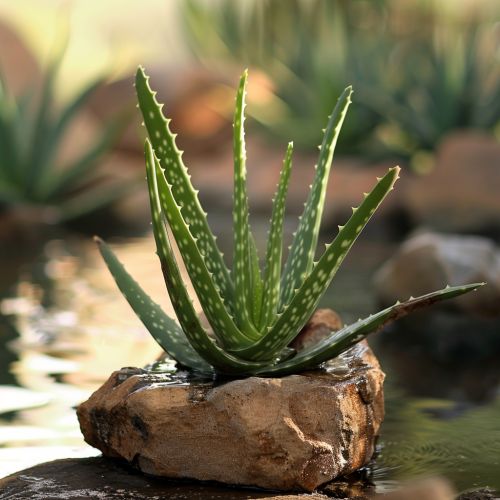Aloe Vera
Introduction
Aloe vera is a succulent plant species of the genus Aloe. An evergreen perennial, it originates from the Arabian Peninsula but grows wild in tropical, semi-tropical, and arid climates around the world. It is cultivated for agricultural and medicinal uses.


Description
Aloe vera is a stemless or very short-stemmed plant growing to 60–100 cm (24–39 in) tall, spreading by offsets. The leaves are thick and fleshy, green to grey-green, with some varieties showing white flecks on their upper and lower stem surfaces. The margin of the leaf is serrated and has small white teeth. The flowers are produced in summer on a spike up to 90 cm (35 in) tall, each flower being pendulous, with a yellow tubular corolla 2–3 cm (0.8–1.2 in) long.
Taxonomy and etymology
The species has a number of synonyms: A. barbadensis Mill., Aloe indica Royle, Aloe perfoliata L. var. vera and A. vulgaris Lam. Common names include Chinese Aloe, Indian Aloe, True Aloe, Barbados Aloe, Burn Aloe, First Aid Plant. The species epithet vera means "true" or "genuine". Some literature identifies the white-spotted form of Aloe vera as Aloe vera var. chinensis; however, the species varies widely with regard to leaf spots and it has been suggested that the spotted form of Aloe vera may be conspecific with A. massawana.
Distribution and habitat
Aloe vera is found in many arid regions of the world. It is thought to have originated in the dry regions of northern Africa. The species does not have any specific chromosomal number that could help determine its origin. It has been widely cultivated throughout the world and especially in the Rio Grande Valley of Texas, in the United States, in the Caribbean, and in Mexico.
Cultivation
Aloe vera can be grown both indoors and outdoors. It prefers well-drained, sandy or loamy soil and is drought resistant. The plant can survive in zone 8b and higher in the United States. It is also commonly grown as a houseplant in temperate climates. The plants can be damaged or killed by excessive water, cold, or insect pests.
Uses
Traditional medicine
Aloe vera has been used for centuries in traditional medicine. The clear gel found inside the plant is often used topically, usually for the treatment of burns, abrasions, psoriasis, and other skin conditions. Aloe vera juice, primarily produced from the green outer leaf, was used in Europe as a laxative.
Dietary supplement
Aloe vera extracts are used in the food industry for their bioactive compounds, including polysaccharides, anthraquinones, acemannan, and various lectins. Aloe vera juice is marketed to support the health of the digestive system, but there is neither scientific evidence nor regulatory approval to support this claim.
Cosmetics
Aloe vera is used in a wide range of cosmetics and personal care products, including lotions, creams, and shampoos. The moisturizing effects of aloe can help alleviate dry, itchy skin associated with eczema and psoriasis.
Research
While there is preliminary evidence of Aloe vera's potential effectiveness in managing chronic non-cancer pain, the quality of the evidence is poor, and more rigorous and larger studies are needed. There is little scientific evidence of the effectiveness or safety of Aloe vera extracts for either cosmetic or medicinal purposes. A 2014 Cochrane review found insufficient evidence for the use of Aloe vera for the treatment of burns.
Safety
Oral ingestion of Aloe vera may cause abdominal cramps and diarrhea which in turn can decrease the absorption of drugs. IARC studies have found ingested non-decolorized liquid Aloe vera to be a possible carcinogen when eaten or ingested.
